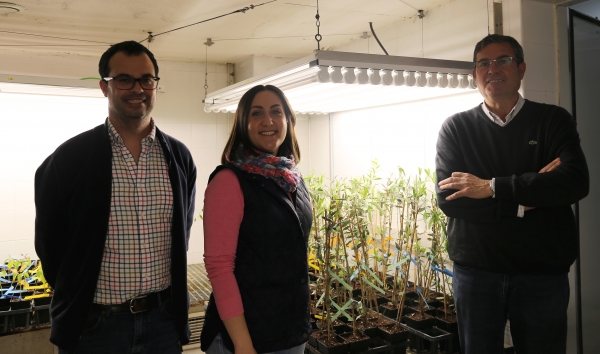Olive tree verticilosis, or Verticillium Wilt of Olive (VWO), is caused by the Verticillium dahliae fungus, considered the most serious disease in olive trees worldwide due to the high mortality levels and damage to production that it causes. Faced with a pathogen that can survive for more than 14 years in soils, and without any effective chemical control method against this disease, the research community is eager to find a solution.
In this context, a solution has emerged: the induction of resistance in the plant emerges by means of certain beneficial microorganisms that are able to deal with the pathogen, as researchers at the María de Maeztu Unit of Excellence - Department of Agronomy, University of Córdoba (DAUCO) - Antonio Trapero, Ana López and Carlos Agustí verified in a study carried out together in collaboration with the Biochemistry and Biotechnology Group at the Universitat Jaume I de Castellón's Department of Agricultural Sciences and the Natural Environment.
After more than a decade working on the search for a biological control method against verticilosis, "we decided to carry out a screening of biological products and biostimulants that could be effective in controlling the disease," explained Professor Trapero. Of the more than 20 effective compounds they found, three were chosen in this study: two beneficial microorganisms (Aureobasidium pullulans and Bacillus amyloliquefaciens) and a copper phosphite fertilizer. "We selected these three compounds because, applied via irrigation, in olive seedlings inoculated with V. dahliaere, they reduced the disease’s development by up to 70%," reported researcher Ana López.
This study delves into these compounds' action mechanism, as they observed that microorganisms did not show a direct effect against the pathogen in vitroassays. Therefore, the hypothesis was proposed that these compounds were involved in the induction of resistance in the plant; that is, improvement in the natural defenses of olive trees that, previously treated, had a greater capacity to cope with the disease after they were infected.
By studying the parameters involved in the activationof these "natural defense" mechanisms of plants, it was found that said microorganisms' mode of action is, indeed, the induction of resistance. "The indicators evaluated were the quantification of Reactive Oxygen Species (ROS), the determination of the hormones involved, and the overexpression of genes related to the induction of resistance, for which we drew on the group at the Universitat Jaume I, expert in the study of these parameters," noted researcher Carlos Agustí.
As for the conclusions, in addition to confirming the activation of the plant's defenses, according to Ana López "the most surprising thing was that the resistance induction triggered by the two microorganisms used is regulated by different metabolic routes. While B. amyloliquefaciens triggers the activation of defenses through the salicylic acid pathway, when we apply A. pullulans we detect that the pathway involved corresponds to that regulated by jasmonic acid)."
One advantage of resistance induction is that it is non-specific and can be expressed against V. dahliae, but also against other pathogens. In the case of the microorganisms studied "we have found that they are also effective when applied via the foliar route, which facilitates their application in the field," emphasized Trapero.
It is there, in the field, where the tests of the next phase of these compounds are now being carried out, applied before infection by V. dahliae to verify their effectiveness under natural field conditions featuring different edaphoclimatic conditions and soils with different pathogen inoculum densities. In this way it will be confirmed whether this control strategy can cope with this pathogen that threatens olive groves.
López-Moral A, Llorens E, Scalschi L, García-Agustín P, Trapero A and Agustí-Brisach C (2022) Resistance Induction in Olive Tree (Olea europaea) Against Verticillium Wilt by Two Beneficial Microorganisms and a Copper Phosphite Fertilizer. Front. PlantSci.13:831794. doi: 10.3389/fpls.2022.831794


